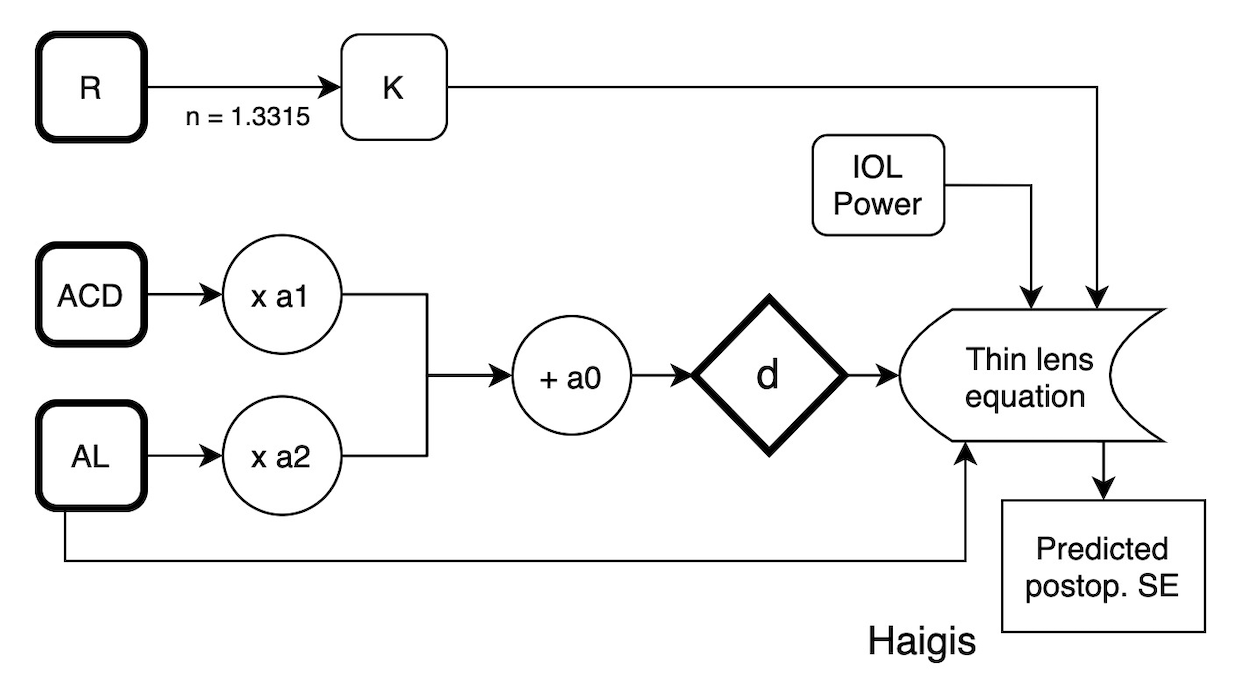How to easily perform the Haigis triple optimization
The Haigis Formula
The Haigis formula is the simplest thin lens formula possible. The ELP (= d value) is predicted using a multiple regression taking ACD and AL as inputs.
def Haigis(AL, R, ACD,a0,a1,a2,power):
n = 1.336
nc = 1.3315
dx = 0.012
d = a0 + a1*ACD + a2*AL
R = R/1000
AL = AL/1000
d = d/1000
Dc = (nc - 1)/(R)
qnum = n * (n - power * (AL - d))
qdenum = n * (AL - d) + d * (n - power *(AL-d))
q = qnum / qdenum
SEpred = round((q - Dc) / (1 + dx*(q - Dc)),3)
return SEpred
Optimizing the Haigis Formula
The Haigis formula can be single-optimized (A0 acts like a "potentiometer" or variable resistor, like the A constant in SRK/T, until a mean prediction error equal to zero is reached) or triple-optimized.
The Haigis triple-optimization is in fact a complete retraining of the formula. The perfect d value is back-calculated for each eye of the dataset. This is the d value giving the real postoperative spherical equivalent when using the biometric values and the implanted IOL power in thin lens equations.
A multiple regression takes ACD and AL as inputs, then allows fitting to predict this "perfect" d value. Et voilà : the intercept is a0, the ACD coefficient is a1, and the AL coefficient is a2.
Back-calculation of the d value
You can back-calculate the d value for a given eye with the following function (As expected you'll need the postoperative SE, ARC, AL and the implanted IOL power).
# AL, R in meters
def solve_d_Haigis(AL, R, power, Rx):
n = 1.336
nc = 1.3315
dx = 0.012
Dc = (nc - 1) / R
z = Dc + Rx/(1-Rx*dx)
b = -power * (AL + n/z)
c = (n * (AL - n/z) + power * AL * n/z)
d = (1 / (2*power)) * (-b - np.sqrt(b**2 - 4 * power * c) )
return dFrom : W.Haigis. "The Haigis formula", in Intraocular Lens Power Calculation, H. John Shammas, Chapter 5, edited by Slack Incorporated, 2004.
# Example :
val = solve_d_Haigis(0.024, 0.0075, 21, -2)
print(val)
#output : 0.005461457048808832The output of this function is in meters : multiply by 1000 before fitting your regression.
Like this :
from sklearn.linear_model import LinearRegression
df['d_Haigis'] = df['d_Haigis'] * 1000
lin = LinearRegression()
lin.fit(df[['ACD','AL']], df['d_Haigis'])
lin.intercept_
# output :
# -0.07756916259537494This is your a0 value !
lin.coef_
# output :
# array([0.39819972, 0.16012471])And the coefficients are a1 and a2, respectively. What a beautifully simple formula! Genius.